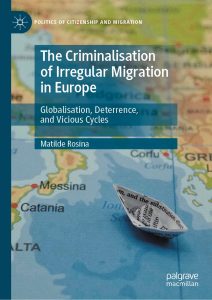We speak to Matilde Rosina about her book, The Criminalisation of Irregular Migration in Europe: Globalisation, Deterrence, and Vicious Cycles, which investigates the realities and consequences of criminalising unauthorised migration in Europe, taking Italy and France as case studies.
You can watch back an LSE Research Showcase with Dr Rosina from 2022 on YouTube, Why making migration a crime doesn’t work.
The Criminalisation of Irregular Migration in Europe: Globalisation, Deterrence, and Vicious Cycles. Matilde Rosina. Springer International Publishing. 2022.
 Q: Why is it such a timely moment to consider the impact and effectiveness of the criminalisation of irregular migration in Europe?
Q: Why is it such a timely moment to consider the impact and effectiveness of the criminalisation of irregular migration in Europe?
Governments throughout Europe are putting more and more emphasis on addressing irregular migration. They often aim to prevent – or deter – migration. Just think of Braverman’s latest speech calling for increased deterrence, or the efforts of Italian and EU politicians to reduce arrivals to Lampedusa.
An often-used, and yet seldom-evaluated, deterrence measure is the criminalisation of migration. This refers to the introduction of a “crime of irregular migration”, so that states employ criminal sanctions to address foreigners’ irregular entry or irregular stay. 25 out of 27 EU member states have such a crime in place, and yet, only two fully evaluated its impact and effectiveness.
In the book, I study the consequences of criminalising migration in two of the EU member states with the highest sanctions: Italy and France. We need more evidence to design policies that are not only more effective, but also more reflective of migrants’ journeys, drivers and experiences.
Deterrence is a strategy to discourage irregular migration to a country, through potential migrants’ fear of negative consequences.
Q: What are the logics behind the idea of deterrence?
Deterrence is a strategy to discourage irregular migration to a country, through potential migrants’ fear of negative consequences. It is based on the idea of rationality, and assumes that people act by calculating the costs and benefits of their actions. As such, the expectation is that if the sanctions for irregular migration (such as fines or prison terms) are made more severe, it will be costlier for people to move, and hence they refrain from doing so.
However, deterrence in the field of migration suffers from several shortcomings, as I argue in the book. First, by focusing on sanctioning migrants who enter irregularly, deterrence fails to address the deeper and more fundamental drivers of migration – first of which economic factors and conflict. Second, deterrence can cause “balloon effects”, re-directing migration flows to other entry points along the border, rather than stopping migration altogether. Third, the political dimension of deterrence may backfire: as policymakers tend to use deterrence to address the concerns of the domestic public (more than those of migrants), they often end up designing inconsistent policies. Fourth, migrants’ knowledge of migration policies in destination countries is regularly overestimated.
Q: You discuss “policy gaps” around the discourse, implementation and effectiveness of migration policies. What are policy gaps and why are they so important for thinking about migration control?
Policy gaps refer to the gap that we often see between the stated goals of migration policies (to stop or reduce migration) and their actual outcomes (often failing to do so). Following the literature, we can identify three types of gaps, between politicians’ rhetoric and the actual design of a policy (discursive gaps), policy design and implementation (implementation gaps), and, finally, policy implementation and overall results (efficacy gaps). Unpacking the reasons for which migration policies fail is crucial to understand how to devise more effective and sensible policies.
In the case of the criminalisation of migration, the government in both Italy and France privileged the domestic audience (as opposed to potential migrants).
Q: You observe that the criminalisation of irregular migration is often deployed as rhetoric directed at domestic audiences rather than to potential migrants. How does this affect the effectiveness and consequences of criminalisation?
In the case of the criminalisation of migration, the government in both Italy and France privileged the domestic audience (as opposed to potential migrants). This made criminalisation emerge as highly incoherent.
In France for instance, the government aimed to expel migrants, but through the crime of migration it forced them to remain on French territory for up to one year, in prison.
In Italy, the crime of migration was criticised by several high-level judges and prosecutors, and yet the government opposed revoking it, fearing that ‘the people would not understand’. Italy was left with an ineffective and counterproductive law, which even lengthened criminal investigations against traffickers.
Q: You argue that criminalisation was a case of “deliberate malintegration” in Italy. Why is that?
This is because, in the months leading up to the criminalisation of migration, back in 2009, the Italian government aimed to simultaneously pursue two contrasting goals.
On the one hand, it aimed to address the public’s security concerns, and to appear to be “doing something” about irregular migration. So, in July 2009 it introduced the crime of migration, which – on paper at least – was very restrictive.
On the other hand, however, the government was acutely aware of the reliance of certain economic sectors (first of which, agriculture and construction) on migration, and sought to avoid damaging them. So, one month after introducing the crime of migration, it adopted an amnesty for almost 300,000 undocumented migrants. Importantly, the government also reduced checks on irregular employment to limit the burden on companies that had already been deeply affected by the global financial crisis.
[Criminalisation] did not increase expulsions. In France, only 3% of people condemned for irregular migration through a criminal trial were expelled. In Italy, the proportion was even lower, about 0.3%.
Q: Why do you argue that criminalisation was ineffective in Italy and France?
In both countries, criminalisation failed to (1) increase expulsions, and (2) reduce migration.
First, it did not increase expulsions. In France, only 3% of people condemned for irregular migration through a criminal trial were expelled. In Italy, the proportion was even lower, about 0.3%. Indeed, beyond criminalisation, practical challenges and the lack of agreements with countries of origin often made (and still make) expulsions difficult to enforce. Across Europe, less than half of the migrants who should be expelled are actually repatriated.
Second, criminalisation did not deter migration. With irregular migration being criminalised, Italy still received over 180,000 sea landings in 2016, and France was consistently among the top five countries in the EU by number of irregularly staying migrants, between 2008 and 2018. Indeed, fluctuations in migration flows are largely determined by factors and dynamics in countries of origin and transit, rather than deterrence policies.
Q: Not only do you find that criminalisation is ineffective as a deterrent, but it can also have a number of negative repercussions. What are some of the “vicious cycles” provoked by the criminalisation of irregular migration?
The criminalisation of migration can, first of all, lead to more, rather than less, in-security. Indeed, harsh rhetoric and restrictive policies put increasing emphasis on the border. When these policies fail to prevent migration, however, the border is shown to be porous, making irregular migration more visible. This in turn increases the sense of insecurity among the domestic public, leading to more demands for restrictive measures, in what emerges as a “vicious cycle of insecurity”.
Rather than stopping migration, deterrence measures re-direct migration to other entry points.
Restrictive measures can also lead to a “balloon effect”: Rather than stopping migration, deterrence measures re-direct migration to other entry points. As an example, after France re-introduced border controls in 2015, migration flows from Italy did not stop. Rather than crossing in Ventimiglia (which was heavily patrolled), many migrants crossed the Italian-French border further North, in the mountains near Bardonecchia. Many others attempted riskier routes, crossing in the hills and woods behind Ventimiglia, or walking on the autoroute. So, we see a shift towards other entry points (a balloon effect), rather than a halt to migration.
Q: You point out that migrants’ information is often overestimated. What did your research into this reveal?
I conducted a questionnaire with over 100 migrants in Italy and France. In Italy, two thirds of respondents were not aware of any of the sanctions for unauthorised migration (such as detention, fines, etc.). Only 2% identified fines as sanctions for irregular entry. In France, no respondent was aware of the possibility of being imprisoned for being irregular.
Through the survey, I also found that most information was acquired through personal networks (like family, friends, or smugglers), whereas the internet played a minor role to inform migrants. Importantly, the few migrants who did know about sanctions only learnt about them once they arrived in the receiving country (Italy or France).
Q: Given the counterproductive and damaging effects of criminalisation, what alternative approaches might we consider instead?
Moving away from the idea of deterrence is a first, key step. Revoking the crime of migration, which as I show in the book is both ineffective and counterproductive, is crucial. More broadly, we need to leave the deterrence paradigm behind and focus on long-term solutions to the structural drivers of migration.
We need to substantially increase legal pathways, for both refugee and labour migration alike.
Second, we need to substantially increase legal pathways, for both refugee and labour migration alike. Only about 4% of the people who need resettlement are brought to safety (based on UNHCR data), and European economies have a strong need for foreign workers (as was shown by the labour shortages during Covid-19 lockdowns).
Finally, we need to change the way we speak about migration. What is the proportion of foreigners in the UK? Most people would answer about 30%, while in reality it is 14.5%. We need to address the misinformation surrounding migration and its effects.
Note: This interview gives the views of the author, and not the position of the LSE Review of Books blog, or of the London School of Economics and Political Science. The interview was conducted by Dr Rosemary Deller, Knowledge Exchange Support Manager at LSE.
Main Image: davide bonaldo on Shutterstock.






